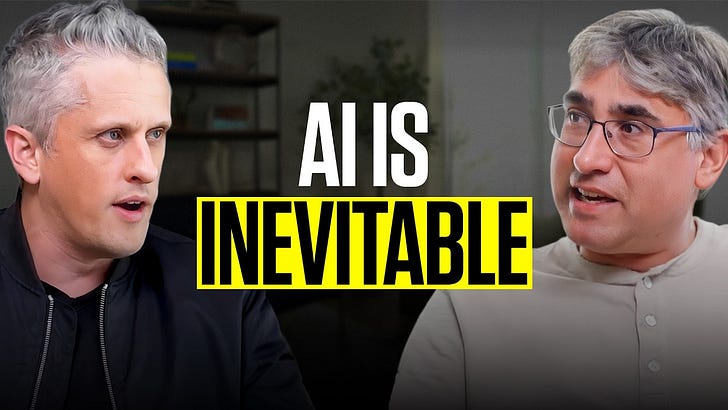📨 Weekly digest: 31 2025 | The accountability abyss: Who owns AI's decisions?
The unclaimed consequence: assigning responsibility for AI's actions
👋🏻 Hello, legends, and welcome to the weekly digest for week 31 of 2025.
The rapid, often unbridled, deployment of AI into real-world applications has opened up an "ethical minefield" that demands immediate and comprehensive attention from decision-makers, board members, and startup founders. It's no longer enough to develop powerful AI; we must now critically address how these systems impact society in terms of bias, privacy, and accountability.
This is a three-part series:
Part 1: The bias trap: when AI reflects and amplifies our prejudices 🪞
AI learns from the data we feed it, and if that data is tainted with historical or societal biases, the AI will not only mirror these prejudices but often intensify them. This isn't a future problem; it's happening now in critical areas like hiring, criminal justice, healthcare, and finance, leading to discriminatory outcomes that perpetuate systemic inequalities. For instance, AI recruitment tools have shown gender bias, and justice algorithms have disproportionately flagged minority groups. Companies must actively seek diverse data, employ bias detection tools, and continuously audit deployed systems to prevent AI from becoming a harmful echo chamber of our past.
👉🏼 Please read part 1 here
Part 2: The privacy peril: safeguarding data in an AI-driven world 🕵️♀️
AI's insatiable hunger for data creates significant privacy concerns, especially when personal and sensitive information is collected, stored, and processed. Issues like excessive data collection, non-consensual repurposing, and surveillance overreach are rampant. We've seen instances of accidental data leaks from AI systems, highlighting the vulnerability of vast data pools. To navigate this peril, organizations must adopt privacy-by-design principles, minimize data collection, ensure robust consent mechanisms, and implement privacy-preserving technologies like federated learning. Strong security measures and regular privacy impact assessments are essential to protect individuals from the invisible hand of data exploitation.
👉🏼 Please read part 2 here
Part 3: The accountability abyss: Who owns AI's decisions? 🔮
When an AI system makes a mistake or causes harm, determining who is responsible can be incredibly challenging, often due to the "black box" nature of complex algorithms. This algorithmic opacity blurs the lines of responsibility among data providers, developers, and deployers, leaving individuals impacted by AI decisions with little recourse. Without clear accountability frameworks and sufficient human oversight, errors can go unaddressed and ethical concerns overlooked. To bridge this abyss, we need Explainable AI (XAI), clear accountability frameworks, human-in-the-loop design, and auditable AI systems that log decision pathways. This ensures that when AI acts, there's always a clear answer to "Who's in charge here?"
This week’s part, please read it below.
Part 3: The accountability abyss: Who owns AI's decisions? 🔮
The final, and perhaps most complex, ethical challenge in AI deployment is the Accountability Abyss. As AI systems become increasingly autonomous and integrated into critical decision-making processes, the question of "Who is responsible when AI makes a mistake or causes harm?" looms larger and larger. For decision-makers, board members, and startup founders, ignoring this question is not just a moral lapse; it's an invitation to legal liability, public backlash, and a fundamental breakdown of trust in your AI initiatives.
The core difficulty stems from several interconnected problems:
The "Black Box" problem (algorithmic opacity): Many of the most powerful AI models, profound neural networks, operate as complex "black boxes." Their decision-making processes are so intricate and nonlinear that even their creators struggle to explain why a particular output was entirely generated. When an AI denies a loan, flags a patient for a specific diagnosis, or recommends a particular legal outcome, the inability to provide a clear, human-understandable explanation for that decision creates an immediate accountability vacuum. How do you challenge a decision you can't understand? How do you assign blame when the logic is opaque?
Blurred Lines of responsibility across the AI lifecycle: The creation and deployment of AI involve a complex ecosystem of actors:
Data providers/curators: Are they responsible if the data is flawed or biased, leading to bad decisions?
Model developers/engineers: Are they liable if the algorithm itself has a flaw, or if it's designed in a way that creates unforeseen risks?
Platform providers/integrators: What about the company that provides the cloud infrastructure or the tools used to build and deploy the AI?
Deploying organization/users: Is the organization that puts the AI into operation ultimately responsible, even if they didn't build it? What about the individual user who interacts with it?
When harm occurs (e.g., an autonomous vehicle causes an accident, an AI misdiagnoses a patient, an AI-powered system wrongly identifies a suspect), pointing to a single point of failure becomes incredibly difficult, often resulting in a blame game that leaves victims without redress.
The challenge of intent and causality: Traditional legal frameworks often rely on concepts of human intent or direct causation. With AI, a decision might be made without human intent, arising from complex interactions within the system. Proving causality between a specific line of code or a particular dataset input and a harmful outcome can be nearly impossible, further complicating legal and ethical accountability.
Over-reliance and automation bias: As AI becomes more sophisticated, there's a natural human tendency to over-rely on its outputs, assuming its decisions are inherently superior or error-free. This "automation bias" can lead to reduced human oversight, where critical AI recommendations are accepted without due diligence, creating a dangerous scenario where human responsibility is abdicated to the machine.
For leadership teams, the implications of this accountability abyss are profound:
Legal exposure and regulatory scrutiny: Governments worldwide are rapidly developing new regulations (like the EU AI Act) specifically designed to address AI accountability. Without clear internal frameworks, organizations face massive fines, protracted legal battles, and the imposition of external oversight.
Reputational backlash: A highly visible incident where an AI system causes harm and no clear party takes responsibility can decimate public trust, leading to boycotts, protests, and a significant loss of market value.
Internal governance gaps: A lack of clear accountability can foster a culture where responsibility is diffuse, inhibiting proper risk management, incident response, and continuous improvement of AI systems.
Barriers to adoption: If customers, partners, or employees don't believe there are clear mechanisms for redress or recourse when AI systems falter, they will be reluctant to engage with your AI-powered products and services.
To navigate this treacherous landscape, organizations must proactively build robust accountability frameworks into their AI strategy. This means:
Embracing explainable AI (XAI): Invest in and demand tools and methodologies that make AI decisions more transparent and interpretable. While full transparency might not always be possible, striving for sufficient explainability to understand the why behind critical decisions is paramount for auditing and redress.
Defining clear roles and responsibilities: Establish explicit lines of accountability across the AI lifecycle within your organization. Who is responsible for data quality? Who signs off on model deployment? Who monitors performance and handles adverse events?
Implementing Human-in-the-Loop (HITL) Design: For critical applications, design AI systems that incorporate meaningful human oversight and intervention points. Humans should have the ability to review, override, and provide feedback to AI recommendations. The goal is augmentation, not automation to the point of abdication.
Ensuring auditability and traceability: Build AI systems that log every input, output, and relevant decision pathway. This creates a digital breadcrumb trail, allowing for forensic analysis in case of an incident, crucial for understanding what went wrong and assigning responsibility.
Establishing robust redress mechanisms: Develop clear, accessible processes for individuals to challenge AI-driven decisions that negatively affect them, providing a pathway for review, explanation, and potential correction or compensation.
Proactive impact assessments: Before deploying AI, particularly in sensitive domains, conduct thorough ethical and societal impact assessments to anticipate potential harms and pre-emptively establish mitigation and accountability plans.
Ultimately, managing the Accountability Abyss is about demonstrating responsible stewardship of powerful technology. It's about ensuring that as AI increasingly shapes our world, the ultimate responsibility for its impact remains firmly within human hands.
Yael.
Previous digests of the series:
Read part 1 here
Read part 2 here
The Daily Wild publications of the week
📨 Weekly digest
Thank you for being a subscriber and for your ongoing support.
If you haven’t already, consider becoming a paying subscriber and joining our growing community.
To support this work for free, consider “liking” this post by tapping the heart icon, sharing it on social media, and/or forwarding it to a friend.
Every little bit helps!






